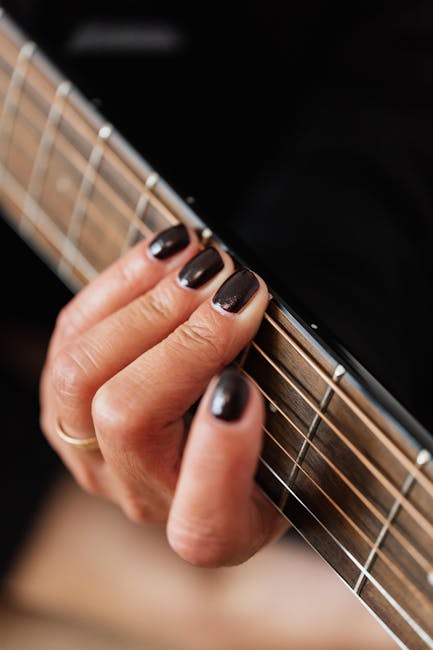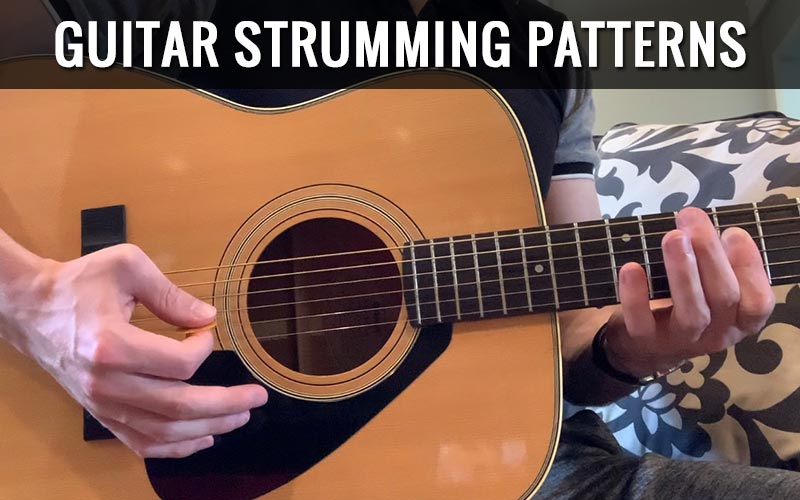guitar-pick-keeps-slipping/” title=”5 Questions to Ask Yourself if Guitar Pick Keeps Slipping”>Strumming a guitar may seem like a simple task, but mastering the art of creating a rich, full sound is a whole different ball game. It’s like trying to juggle flaming swords while riding a unicycle – challenging, but oh so rewarding when you finally get it right. So grab your guitar, grab your sense of humor, and let’s dive into the wonderful world of perfecting your strumming technique for a sound that will make angels weep tears of joy.
Contents
- 1 Establishing the Foundation: Mastering the Basics of Guitar Strumming
- 2 Exploring Strumming Patterns: The Rhythm that Defines Your Sound
- 3 The Art of Dynamics: Varying Strumming Intensity for Emotional Impact
- 4 Incorporating Advanced Techniques: Muting, Fan Strumming, and Rasgueado
- 5 Perfecting the Right Hand: Position, Movement, and Angle for Optimal Sound
- 6 Embracing the Role of the Left Hand: Chord Changes and Finger Placement
- 7 Practice Strategies for Continuous Improvement: Forming a Routine That Works
- 8 FAQs
- 9 Strum on, Rockstar!
Establishing the Foundation: Mastering the Basics of Guitar Strumming
So you’ve decided to embark on the epic journey of becoming a master guitarist. Congratulations! But before you start shredding like a rock god, you need to establish a solid foundation by mastering the basics of guitar strumming.
Strumming is like the bread and butter of playing the guitar – without it, you’re just left with a fancy piece of wood with strings. But fear not, dear aspiring guitarist, for we are here to guide you through this crucial first step with a sprinkle of humor and a dash of sass.
Below are some key tips to help you become a strumming sensation:
- Hold the Pick Like You Mean It: Don’t daintily grasp the pick between your fingers like it’s a delicate flower. Grab that bad boy with conviction and wield it like a mighty warrior.
- Rhythm is Your Best Friend: No one likes a guitarist who sounds like a confused metronome. Practice keeping a steady rhythm until it becomes second nature.
- Experiment with Different Strumming Patterns: Don’t be afraid to mix things up and try out various strumming patterns. Who knows, you might stumble upon the next big hit!

Exploring Strumming Patterns: The Rhythm that Defines Your Sound
When it comes to playing guitar, strumming patterns are like the secret sauce that gives your music its flavor. They can make or break a song, so it’s important to explore different patterns to find the one that best suits your style.
Think of strumming patterns as the heartbeat of your music – they set the rhythm and drive the song forward. It’s like being the drummer of a band, except you’re using a guitar pick instead of drumsticks.
Experiment with different strumming patterns to see which one gets your foot tapping and your head bobbing. Don’t be afraid to mix it up and try something new – who knows, you might stumble upon a pattern that becomes your signature sound.
So next time you pick up your guitar, remember that strumming patterns are more than just a series of up and down strokes. They’re the key to unlocking your musical potential and creating a sound that is uniquely yours. Rock on, fellow strummers!

The Art of Dynamics: Varying Strumming Intensity for Emotional Impact
Ever wonder why some songs just hit you right in the feels with their emotional intensity? It’s all about mastering the art of dynamics, specifically varying your strumming intensity to create a rollercoaster of emotions for your listeners.
Picture this: you’re strumming along to a slow, melancholic tune, gently brushing your guitar strings like you’re petting a newborn kitten. And just when your audience starts to get lost in the somber mood, BAM! You hit them with a sudden burst of energy, strumming with the force of a thousand angry unicorns. It’s all about those peaks and valleys, folks.
Think of your strumming intensity as a secret weapon in your musical arsenal. Use it to build tension, convey emotion, and keep your listeners on the edge of their seats. With the right touch, you can make them laugh, cry, or spontaneously break out into an interpretive dance (hey, we don’t judge).
So next time you’re jamming out, don’t be afraid to play around with your strumming intensity. Experiment with soft strokes and powerful hits, and see how it transforms your music from meh to mesmerizing. Remember, dynamics are the key to unlocking the true emotional impact of your songs. Play on, you wild musical genius!

Incorporating Advanced Techniques: Muting, Fan Strumming, and Rasgueado
So, you’ve mastered the basic strumming patterns and chord progressions. Now it’s time to take your guitar playing to the next level with some advanced techniques!
First up, we have muting. This technique involves lightly resting your palm on the strings to create a percussive sound while strumming. It adds a funky, staccato effect to your playing that will have everyone grooving along.
Next, let’s talk about fan strumming. This flashy technique involves quickly strumming up and down with your fingers spread out like a fan. It creates a unique, swirling sound that will make you feel like a rockstar on stage. Just be careful not to accidentally hit yourself in the face with your own hand!
Finally, we have rasgueado, a traditional flamenco technique that involves rapid strumming with all four fingers of your picking hand. It produces a powerful, dramatic sound that will add flair to any song. Just be prepared for your fingers to feel like they’re on fire after practicing this one!
Perfecting the Right Hand: Position, Movement, and Angle for Optimal Sound
In the vast world of piano playing, perfecting your right hand technique is essential for creating optimal sound. From the position of your hand to the movement and angle, every little detail matters in producing beautiful music.
First things first, let’s talk about the position of your right hand. You want to make sure it’s relaxed and slightly curved, like you’re holding a delicate bubble that you don’t want to pop. Keep those fingers nice and rounded, like you’re about to tickle the ivories with finesse.
When it comes to movement, think of your right hand as a graceful ballerina gliding across the keys. Smooth, fluid motions will create a seamless sound that will dazzle anyone within earshot. And don’t forget about the angle of your hand – it should be slightly tilted towards the pinky side, like a fancy teacup at a posh afternoon tea.
So there you have it – the keys to perfecting your right hand technique for optimal sound. Remember, practice makes perfect, so keep tinkling those ivories and soon enough you’ll be the maestro of the music world!
Embracing the Role of the Left Hand: Chord Changes and Finger Placement
Since the dawn of time (or at least since the invention of the guitar), the left hand has often been overlooked in favor of its flashy counterpart, the right hand. However, it’s time to give the left hand the recognition it deserves, especially when it comes to chord changes and finger placement.
When it comes to chord changes, the left hand is truly the unsung hero of the guitar. It’s responsible for seamlessly transitioning between chords, creating harmonious melodies, and wowing audiences with its dexterity. So next time you nail that tricky chord progression, give your left hand a pat on the back (or a high-five if you’re feeling extra generous).
Proper finger placement is key to mastering the art of guitar playing, and the left hand plays a crucial role in this. From barre chords to complex fingerpicking patterns, your left hand is constantly working overtime to ensure every note is hit just right. So make sure to show your left hand some love by practicing good finger placement and giving it the attention it deserves.
So remember, the next time you pick up your guitar, don’t forget about the trusty left hand. Embrace its role in chord changes and finger placement, and you’ll be well on your way to becoming a guitar virtuoso. Who knows, maybe one day your left hand will be the star of the show!
Practice Strategies for Continuous Improvement: Forming a Routine That Works
Everyone knows that in order to improve at something, you need to practice. But how do you form a routine that actually works for continuous improvement? Here are some creative strategies to help you stay on track:
- **Mix it up**: Don’t get stuck in a boring routine. Try different practice methods to keep things interesting. Whether it’s listening to music while you practice or incorporating games into your routine, find what works for you.
- **Set goals**: Having clear goals can help motivate you to keep practicing. Whether it’s mastering a specific skill or achieving a certain level of proficiency, having something to work towards can make all the difference.
- **Track your progress**: Keep a journal or log of your practice sessions. This can help you see how far you’ve come and identify areas where you still need improvement.
Remember, practice doesn’t make perfect. Perfect practice makes perfect. Focus on practicing with purpose and intention, and you’ll see continuous improvement in no time!
FAQs
What is the secret to achieving a rich sound when strumming the guitar?
It’s all about finding that sweet spot between hitting the strings too softly and too aggressively. You want to caress those strings like they’re your favorite pet, not whack them like they owe you money.
Are there any specific techniques I can use to enhance my guitar strumming?
Absolutely! Experiment with different strumming patterns, vary your dynamics, and don’t be afraid to use your fingers instead of a pick for a softer, more nuanced sound. And remember, practice makes perfect!
How can I improve my rhythm and timing when strumming the guitar?
Tap those feet like you’re trying to put out a fire, and count out loud if you have to. Focus on locking in with the beat and don’t be afraid to groove a little – it’s not a crime to get funky with your strumming.
Should I be using any specific equipment or accessories to enhance my guitar strumming?
A good quality guitar pick can make all the difference, but don’t be afraid to experiment with your bare fingers, a thumb pick, or even a coin for a unique sound. And don’t forget to invest in a metronome to keep your timing on point!
How can I add more dynamics and emotion to my guitar strumming?
Play with feeling, dammit! Don’t just strum mechanically – put some soul into it. Experiment with accents, muting, and even guitar slides for a more expressive sound. And remember, music is about storytelling, so let your emotions shine through your playing.
Strum on, Rockstar!
Congratulations, you’ve now unlocked the secrets to perfecting your guitar strumming and creating a richer sound. Remember, practice makes perfect, so keep strumming away and soon you’ll be rocking out like a true guitar hero. Now go forth, play those strings like they’ve never been played before, and unleash your inner rockstar on the world! Keep strumming, keep shredding, and keep rocking on!



